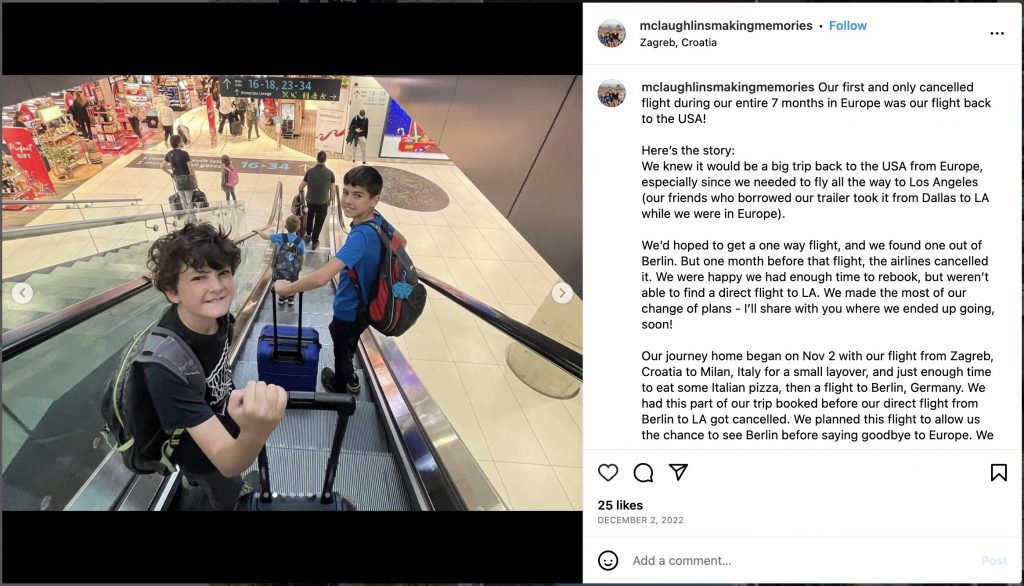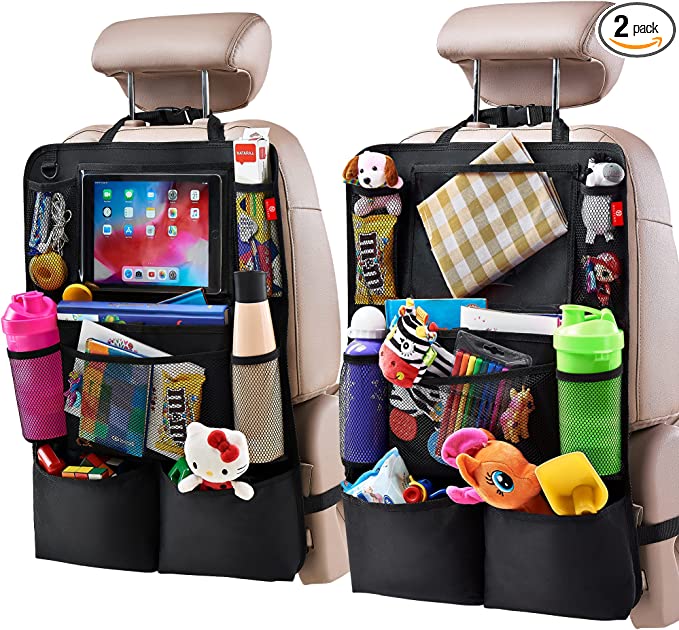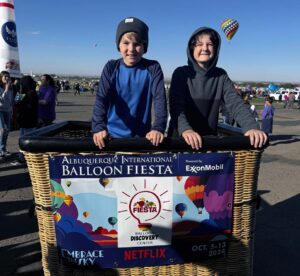Whether you’re planning to travel on a budget abroad or take a road trip a few cities away, traveling as a family can be a lot of fun, but along with the process can come some challenges.
While we see plenty of Instagram-worthy travel moments online, we don’t usually see the lineups, change of plans, and the ‘downtime’ moments that are just as integral to the process as that waterfall selfie.
We’ve put some ideas together to help get through the “travel” part of family travel so you can enjoy your destination once you arrive once you’ve run out of things to “I Spy” to keep yourself occupied.
(Disclaimer: Some of the links and recommendations in this post are affiliate links. We may make a comission if you choose to make a purchase at no cost to you. Someone has to put gas in the tank.)
Tips For Waiting In The Airport As A Family
If this is your first time flying with your kids, check out this post about top tips for flying on an airplane for the first time but before you get to that point, you’ll need to spend some time getting through the airport wait.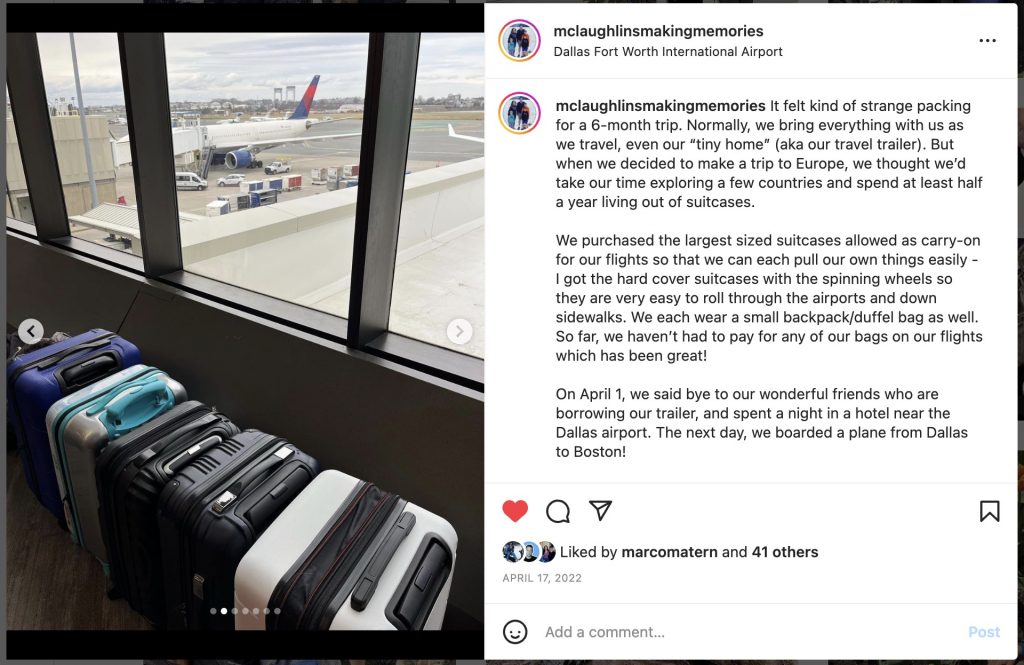
1. Play airport-themed games:
Create games that involve spotting different aircraft types, guessing destinations based on the airport codes on the screens, or identifying different airport facilities.
2. Explore the airport:
Most people arrive at the airport with a few hours to spare, so take a walk with your family and explore different shops, restaurants, and amenities. Some airports even have play areas or interactive exhibits specifically designed for children. A quick search ahead of time can help you know what to expect at the terminal you’ll be waiting in.
3. Bring coloring or activity books:
Pack coloring books, puzzles, reading books, or activity books to keep children occupied during long waits. These can be great quiet activities that won’t disturb other travelers. If you want to give your kid screen time (we do, but we usually reserve that for the plane itself), have the device on silent or have your child wear headphones.
Use Headphones: DO NOT play baby shark at full volume on repeat in the waiting area. Some people are already tense about the prospect of flying, so be respectful and don’t take any chances of increasing that apprehension.
If your kids aren’t comfortable with regular headphones, try a headband like this:
4. Take advantage of airport services:
Instead of paying for your own food, check out the cost and availability of an airport lounge. Often the lounge has food included, offsetting the lounge’s cost but check for restrictions as some are 18+ while others allow in kids under 2 for free, and some are only for passengers on specific airlines.
5. Listen to music or podcasts:
Bring headphones and listen to music or podcasts together as a family. This can be a great way to pass the time and relax while waiting for your flight.
6. Take Photos And Videos At The Airport:
These can serve as fun mementos and allow you to remember your unique experiences during your travels. Like with headphones, be respectful of the people around you who may be experiencing an elevated level of anxiety in anticipation of their flight.
7. Play card or board games:
Pack a deck of cards or a portable board game that the whole family can enjoy. Here are some of our favorite travel-friendly games – perfect for both the airport and the plane.
8. Learn about the destination you’ll be visiting:
YouTube allows you to learn about your trip’s destination, and nothing will help you pass the time waiting to get on the plane like the anticipation of what you’ll experience on the other side of the trip.
If you’re going to visit family or friends, look at recent pictures so your kids can put names to faces before you arrive. If you’re going to a specific destination or event, learn some fun facts about that area.
If you’ll be pet-sitting for your family vacation, look through pictures of the pets you’ll be spending time with and have your kids learn their names before you arrive. We use Trusted Housesitters to find petsitting opportunities. Here’s our review of Trusted Housesitters.
Things To Do On Airplanes With Kids
For families, passing the time during a flight can be essential to keeping everyone entertained and engaged. Here are some ideas to make the most of the journey:
View this post on Instagram
1. Bring entertainment:
Pack various forms of entertainment such as books, magazines, tablets, or e-readers loaded with movies, shows, or games that cater to different age groups. Headphones or earbuds are essential when in a small space with fellow passengers. Obviously, the amount you can bring will depend on what you determine is the best luggage for traveling as a family.
2. Play travel-friendly games:
Bring along travel-friendly games like card games, travel-sized board games, or magnetic games. These can provide amusement and help pass the time for both kids and adults.
3. Engage in creative activities:
Encourage creativity by providing coloring books, activity books, or puzzles. Engaging in these activities can be both fun and calming during the flight.
4. Play traditional games:
Classic games like I Spy, 20 Questions, or the Alphabet Game can be played by the entire family, making the flight interactive and enjoyable.
5. Carry snacks and treats:
Having a variety of snacks and treats can not only keep hunger at bay but also be used as a distraction or reward during the flight. Consider packing items like granola bars, trail mix, or small candies.
6. Listen to music or podcasts:
Load favorite songs or podcasts onto personal devices and bring comfortable headphones. Listening to music or engaging podcasts can help pass the time and create a pleasant atmosphere.
7. Plan in-flight activities:
Research airlines that provide in-flight entertainment systems with movies, TV shows, or interactive games. Take advantage of these offerings and plan accordingly (but don’t rely solely on in-flight entertainment since sometimes airlines experience technical difficulties with these systems).
8. Take stretch breaks:
Sitting for long periods during a flight can be tiring and uncomfortable. Encourage everyone to take regular breaks, walk around the cabin, and do simple stretches or exercises to stay comfortable and prevent restlessness.
9. Sleep or rest:
For longer flights or overnight journeys, encourage family members to take naps or rest to ensure they feel refreshed at their destination.
Remember to be mindful of the comfort and well-being of fellow passengers on the plane, and be considerate of noise levels and personal space. With a mix of entertainment options and engaging activities, families can help make the flight time more enjoyable and pass quickly while creating lasting memories.
View this post on Instagram
Tips to Pass Time On A Family Road Trip
View this post on Instagram
1. Try out these easy car games for your next road trip:
- “I Spy”
- The alphabet game. Choose a category (like Zoo Animals or Ice Cream Flavors). Player one names something in the category starting with A, then Player two names something starting with B. Continue through the alphabet until someone gets stumped and takes longer than 10 seconds to answer.
- The license plate game. Look at license plates from other cars for an A. Once you’ve found an A, look for B. Go through the alphabet (silently), and the winner announces once they’ve found Z.
2. Sing-alongs and music games:
- Create a Spotify playlist of favorite songs in a particular theme or sing traditional road trip tunes together.
- Play “Name that song.” Choose a playlist on Spotify (like 80’s hits, children’s classics, or country love songs), and everyone in the car tries to name the song title and artist first. Keep track of points; the first one to 10 wins, then choose a new playlist.
3. Listen to audiobooks or podcasts:
Choose audiobooks or podcasts that the whole family can enjoy. This can be a great way to have shared entertainment during the drive, and at the end of each podcast, you can talk about what you learned or what questions you still have about the topic.
4. Have storytelling sessions:
Take turns telling stories or have a collaborative session where each family member adds to the story. Change the format by having each person add a sentence or add an idea, or even just one word at a time.
Turn on your iPhone voice memo recording app, then after your next gas or restroom stop, playback the story on your stereo.
5. Plan fun pit stops:
Research and plan interesting pit stops along your route. This could include visiting roadside attractions, national parks,, landmarks, or local restaurants. These could be things you plan ahead or simply stopping on a whim for an intriguing billboard or road sign.
Here’s a water fall we stumbled upon during a family road trip through northern Ontario.
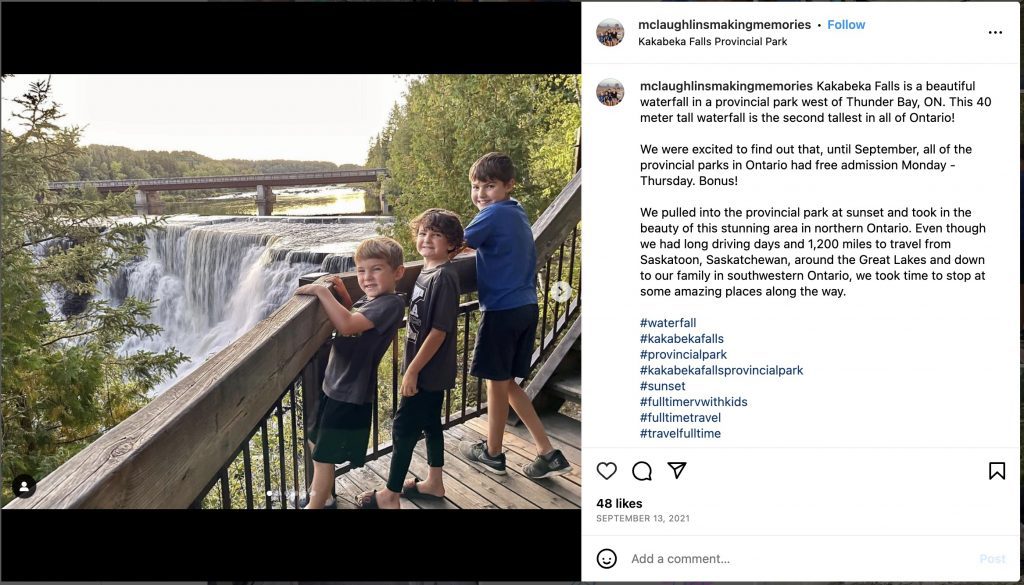
6. Play travel bingo:
Create your own travel bingo cards featuring items you’re likely to see during the trip, such as specific types of vehicles, animals, or landmarks. Cross them off as you spot them.
7. Watch movies or TV shows:
If your vehicle has a DVD player or screens, bring some favorite family movies or TV shows to watch together. Alternatively, consider using a tablet with downloaded content.
Save Money With These Road Trip Snack Ideas For Families:
When choosing road trip snacks for your family, focusing on easy-to-pack options that require minimal preparation and offer a blend of nutrition and tasty treats is helpful.
Staying hydrated is essential, so pack plenty of water. Using small coolers or insulated bags to keep perishable items fresh is a practical idea. With these snack choices, families can enjoy healthy, satisfying, and enjoyable treats to keep them fueled and happy throughout their road trip.
1. Fresh fruit: Pack fruits like apples, oranges, grapes, berries, or sliced melons. They are refreshing, easy to eat, and provide essential vitamins and hydration.
2. Trail mix: Make your own trail mix by combining nuts, dried fruits, whole-grain cereals, and a sprinkle of chocolate or yogurt-covered treats for an energy-boosting and satisfying snack.
3. Veggie sticks and hummus: Prepare cut-up vegetables like carrots, celery, bell peppers, and cucumber, and pair them with individual servings of hummus for a healthy and crunchy snack.
4. Cheese and crackers: Pack a selection of sliced or mini cheeses along with whole-grain crackers. This combination offers protein, calcium, and a savory treat.
5. Granola bars or energy bars: Choose bars that are high in fiber, protein, and low in added sugars. They provide a quick and convenient source of energy during the journey.
6. Popcorn: Air-popped or lightly seasoned popcorn is a low-calorie and crunchy snack option that can be shared among family members.
7. Sandwiches or wraps: Prepare sandwiches or wraps with preferred fillings like lean meats, cheese, lettuce, and spreads. Opt for items that won’t easily spoil without refrigeration.
8. Yogurt cups or tubes: Individual yogurt cups or tubes make for easy, mess-free snacks. Choose low-sugar or Greek yogurt options for added protein.
9. Hard-boiled eggs: Preparing hard-boiled eggs in advance and storing them in a cooler can provide a protein-rich snack that is easy to eat on the go.
10. Treats and sweets: Include a small selection of your family’s favorite indulgences like cookies, pretzels, or a few pieces of chocolate for a special treat during the trip.
Remember to stay hydrated and pack plenty of water as well. Having small coolers or insulated bags is also a good idea to keep perishable items fresh.
What are the benefits of a family road trip?
We can often romanticize flying overseas and spending family vacations in an exotic location, but sometimes the best way to spend time together is simply a road trip.
1. Quality bonding time:
Road trips provide an excellent opportunity for families to spend quality time together. Being in close proximity for an extended period allows for deeper conversations, shared activities, and creates lasting memories.
Alternatively, close proximity means you’ll want to plan plenty of stops along the to stretch your legs and get some fresh air.
2. Adventure and exploration:
Road trips offer a sense of adventure and the opportunity to explore new places. Families can discover hidden gems, visit famous landmarks, and experience different cultures. Instead of the destination being the goal of a road trip, getting there is part of the experience.
3. Learning opportunities:
Traveling to different locations exposes children (and adults) to new experiences, cultures, and perspectives. They can learn about history, geography, and local customs, enhancing their education and broadening their understanding of the world.
4. Strengthen Bonds:
The shared experiences and challenges of a road trip can strengthen family bonds. Working together to navigate, plan, and overcome obstacles fosters cooperation, communication, and teamwork among family members.
5. Disconnect from technology:
Going on a road trip allows families to disconnect from technology and spend quality time together without distractions. This can lead to deeper connections, meaningful conversations, and focused family interactions.
Yeah, this is nice in theory, but in practicality, plan for some screen time when the “Are we there yet?”s get too frequent.
6. Creating lifelong memories:
Road trips provide an opportunity to create lasting memories that family members can cherish for years to come. The shared experiences, inside jokes, and funny moments become part of the family’s collective history and can be revisited and reminisced upon in the future.
We regularly talk about the petsitting we’ve done as a family and look forward to housesitting again in the future.
8. Cost-effective for your travel budget:
Road trips can be a cost-effective way to travel, (and one of our favorite budget-friendly travel hacks for families) as they eliminate the need for expensive flights and accommodation. Taking your car can also save on the cost of a car rental at your destination. Families can save money by camping, staying in budget-friendly accommodations, and preparing their own meals.
Overall, family road trips offer a range of benefits, including quality time together, adventure, learning opportunities, building resilience, and creating lasting memories.
Should we take multiple short family vacations each year or one longer family vacation?
Taking a longer family vacation compared to a few shorter family vacations throughout the year has its pros and cons.
You may be weighing taking Thursday and Friday off a few times throughout the year compared to taking your full two weeks at once. Here are some thoughts on the pros and cons of each:
Longer Family Vacation Pros:
1. Deeper relaxation:
A longer vacation allows for more time to unwind and fully disconnect from daily routines and responsibilities, giving everyone in the family a chance to relax and rejuvenate.
2. More immersive experience:
With an extended period of time, families have the opportunity to delve deeper into the destination they visit. They can explore various attractions, engage in local activities, and truly immerse themselves in the culture instead of choosing just a few things to visit over a weekend.
3. Flexibility in planning:
Longer vacations offer more flexibility when it comes to planning itineraries. Families can allot time for spontaneous activities, longer excursions, and can adjust plans to better suit everyone’s preferences.
4. Longer Vacations Can Work Out Less Expensive:
When planning a longer family vacation, there are several ways it may lead to cost savings.
Firstly, accommodations often offer discounted rates for extended stays, making the nightly rate more affordable compared to booking multiple shorter stays. Additionally, transportation costs may be reduced as airlines frequently have discounted fares for round-trip bookings, and car rental companies often provide lower rates on rental cars for longer rental periods.
Secondly, families can save on food expenses by choosing accommodations with kitchen facilities and preparing some meals themselves, which is often more budget-friendly than a hotel room or dining out for every meal.
Finally, destinations may offer discounts for attractions and activities when purchased for longer periods or in bulk, making it more cost-effective for families to explore various attractions.
It is important, however, to carefully evaluate whether cost savings will offset other factors. For example, families should consider potential loss of income from an extended time away from work or missed school days.
Not all destinations or providers offer cost savings for longer vacations, so it’s advisable to compare prices and explore different options for budget travel. With thorough research and planning, a longer family vacation can often provide opportunities for cost savings while creating lasting memories.
Longer Family Vacation Cons:
Taking just a long vacation has its drawbacks, including the significant time commitment required, potential higher costs due to increased travel, accommodation, and meal expenses throughout an extended period, as well as the more complex planning and logistics involved in coordinating schedules, bookings, and activities for a longer stay.
These factors may pose challenges for families with limited time availability, restricted budgets, or difficulty organizing an extended absence from work or other obligations.
1. Time commitment:
A longer vacation requires a significant time commitment, which may not be feasible for some families due to work, school, or other obligations.
2. Higher costs:
Longer vacations can be more expensive due to increased travel, accommodation, car rentals, and meal expenses. Families need to consider the added costs that come with prolonged periods away from home.
3. Planning and logistics:
Planning a longer vacation can be more complex, as it involves coordinating schedules, booking accommodations for a more extended period, and organizing various activities and attractions to ensure everyone is engaged and entertained throughout the trip.
Shorter Family Vacations Pros:
1. Easier scheduling:
Shorter vacations are typically easier to fit into busy schedules, as they require less time away from work, school, and other commitments, plus there less “what to do” planning if you’re only visiting a destination for a day or two.
2. Lower total costs for saving money:
In general, shorter vacations tend to be less expensive, as families have fewer days to account for in terms of accommodation, meals, and overall travel expenses.
3. Less planning and logistics:
Planning for a shorter vacation can be less time-consuming, as families have fewer days to fill with activities and attractions, making it simpler to create an itinerary.
Shorter Family Vacation Cons:
1. Limited time for relaxation:
With shorter vacations, there is less time for ultimate relaxation, as families may feel rushed to make the most of their limited time.
2. Less immersive experience:
Shorter vacations may not provide enough time to immerse your family in your destination fully. Families might miss out on attractions or cultural experiences requiring a longer stay.
3. Potential for feeling rushed:
With a limited number of days, there may be pressure to fit in many activities, resulting in a rushed and less relaxed experience for the family.
Choosing between a longer family vacation and a few shorter ones depends on individual preferences, time availability, budget, and how long you’d like to explore your destination.
Families should consider their specific circumstances and priorities when deciding which option suits them best.
Why traveling with family is important for a child’s development
Traveling with your family is a pretty cool way for kids to learn and grow. They get to see different cultures, places, and people up close and personal, not just from books or online.
It helps them understand that everyone is different and that’s okay. Plus, they get better at striking up a conversation with people they’ve never met before.
Traveling can be unpredictable too, like when the weather changes or plans go sideways. This teaches them to go with the flow and bounce back from tough spots.
Best of all, going on adventures together brings our family closer. At the end of the day, travel helps kids see the world in a whole new light.
Some final thoughts as you start the car:
The key to making memories and enjoying time together as a family on vacation is prioritizing connection and shared experiences. It’s not about the destination or specific activities but the quality time spent together, the conversations, the laughter, and the bonds that are strengthened during these moments.
No matter how a family chooses to take a vacation (from the length to the budget), focusing on togetherness and creating lasting memories will ensure a meaningful experience for every family member.


